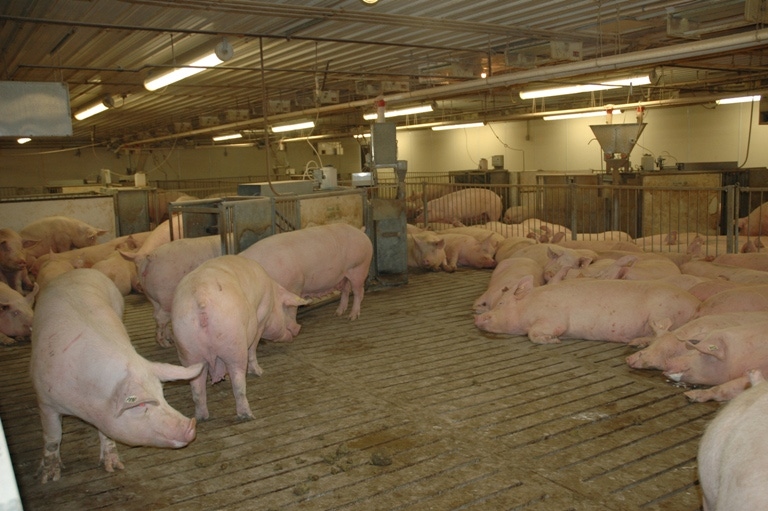Much research has been undertaken in the use of distiller’s dried grains with solubles (DDGS) in growing pigs, but little attention has been paid to the use of the ethanol byproducts on female reproduction.
December 15, 2012

Much research has been undertaken in the use of distiller’s dried grains with solubles (DDGS) in growing pigs, but little attention has been paid to the use of the ethanol byproducts on female reproduction.
Sows are ideal candidates for feeding DDGS because of the moderately high-fiber content. While increases in reproductive performance and improved welfare have been attributed to feeding high-fiber diets to sows, long-term studies have not been conducted with DDGS to confirm or refute those perceptions. In addition, increasing fiber in diets could theoretically increase slurry output, which would in turn decrease storage capacity of manure storage facilities.
To answer these and other questions, an experiment was conducted to evaluate the interactive effects of dietary DDGS and housing system on sow and litter performance, sow longevity and welfare and manure production and composition. Researchers selected 311 gilts and 90 first-parity sows and randomly assigned them to housing and dietary treatments, which were maintained through three reproductive cycles.
In the respective treatments, sows were fed either a fortified corn-soybean meal control diet (203 females designated CON) during gestation and lactation or diets containing 40% DDGS in gestation and 20% DDGS in lactation (198 females designated DDGS). Within dietary treatment, half of the sows were housed in individual stalls, while the other half were housed in groups of 50 in pens equipped with an electronic sow feeding (ESF) system during gestation. Sows were offered their assigned diets based on body condition during gestation and ad-libitum fed during lactation. Results are summarized as follows:
Sow and litter performance: Sows fed DDGS were lighter and had less backfat depth than CON-fed sows at the end of each reproductive cycle (Table 1).

Dietary DDGS did not affect total number of piglets born per litter, but sows fed DDGS farrowed fewer live piglets/litter (11.0 vs. 11.6, respectively) and more stillborn piglets/litter (0.9 vs. 0.7, respectively) than CON-fed females. The smaller litters from DDGS-fed females was reflected through crossfostering (10.2 vs. 10.6, respectively) and at weaning (9.8 vs. 10.2, respectively) compared with CON-fed females.
Litter birth weights were not influenced by diet, but weaning weights were negatively affected when DDGS was fed. Weight gain was lower for litters nursing sows fed DDGS, especially in the first reproductive cycle. Sows fed DDGS and housed in pens had the lowest litter weight gain compared with sows assigned to the other three treatments. Diet did not affect piglet preweaning mortality, sow average daily feed intake (ADFI) during lactation or wean-to-estrus interval.
Sow longevity and welfare: Diet had no statistically significant effects on percentage of sows completing the first, second or third reproductive cycles. However, housing sows in pens significantly reduced the proportion of sows that completed two and three reproductive cycles. Overall, the percentage of sows that completed the experiment was 63.9% for CON-fed sows (71.8%, stalls; 56%, pens) and 60.8% for DDGS-fed sows (66.0%, stalls; 55.5%, pens).
Feeding DDGS decreased the number of piglets born alive and tended to decrease the number of pigs weaned for sows over three reproductive cycles.
Overall, feeding DDGS reduced the total number of pigs weaned by 0.8. Housing sows in pens of 50 sows during gestation reduced the total number of pigs weaned on average per sow over the period of the study by 2.1 piglets.
Behavioral data were collected during the second reproductive cycle after the dietary and housing treatments were initiated. Behavior was tracked on 40 “focal” sows in the group-housing system and 27 sows in stalls from the four breeding groups. Within each breeding group, focal sows were delegated to the same pen or row of stalls. Behavior of the focal sows was video-recorded for 24 hours immediately after mixing in group-housed sows and within 7-10 days after sows were moved to stalls after weaning. Sows were mated before mixing or being placed in stalls.
Sows fed DDGS in pens were more aggressive, engaging in longer and more aggressive fights compared with CON-fed sows. In contrast, DDGS-fed sows in stalls spent more time resting and less time engaging in stereotypic behaviors than sows assigned to the CON diet, which suggests sows were more satiated and content. It is not clear why there seemed to be a differential response to dietary DDGS in stalls vs. pens.
Slurry production and composition: Feces and urine were collected for three days during Weeks 6 to 10 in gestation during the sows’ first or third reproductive cycles (9 and 10 CON-fed sows, respectively and 10 and 11 DDGS-fed sows, respectively). The goal was to determine apparent dry matter digestibility of diets and output and composition of slurry.
Feeding DDGS decreased diet dry matter digestibility compared with feeding CON (76.8% vs. 82.9%, respectively). Sows fed DDGS excreted more fresh feces than sows fed CON (755 vs. 561 grams/day, respectively). However, slurry production (feces plus urine) was no different between DDGS- and CON-fed sows.
Concentration of nitrogen, phosphorus and potassium in excreted slurry was no different between sows fed the two diets.
In conclusion, feeding diets containing 40% DDGS in gestation and 20% in lactation decreased the number of piglets born alive and piglets weaned per litter, and reduced litter weight gain, but had no effect on sow longevity or slurry production. Feeding DDGS increased aggressive interactions in group-housed sows but increased resting time and decreased time spent on stereotypic behaviors in sows housed in stalls.
Researchers: X.J. Li and Gerald Shurson, University of Minnesota (U of M), St. Paul; Lee J. Johnston and Y. Z. Li, U of M West Central Research and Outreach Center, Morris; and Sam K. Baidoo, U of M Southern Research and Outreach Center, Waseca. Contact Johnston by phone (320) 589-1711 or e-mail [email protected].
You May Also Like



